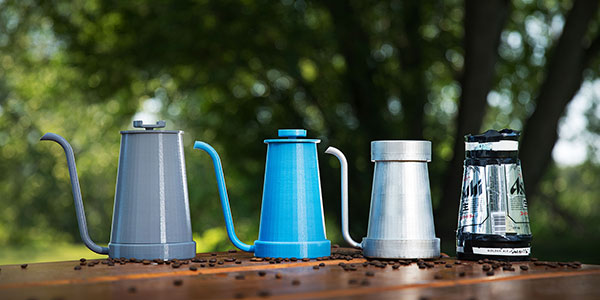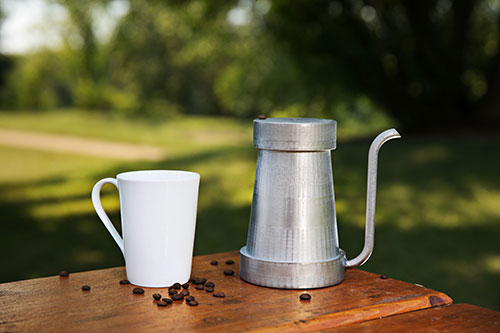Pursuit of the perfect cup leads to a prototype and a new business venture
The pour-over may be one of the simplest yet most appreciated brewing methods among coffee connoisseurs. In boutique cafés, baristas add water to cones of gourmet grounds placed over cups, extracting maximum flavour and richness. Discerning customers happily wait from 2-and-a-half to 4 minutes for their caffeine kick.
Edmonton entrepreneurs Matthew Semaka and Steven Osterlund wanted to enjoy that same experience – and coffee – outside the café. “We talked about being able to go to the river valley and make a cup of nice coffee with a small kit,” says Osterlund. “It has just kind of grown from there.”
With the help of NAIT’s 3D metal printer – the only one west of Winnipeg – the pair has developed a one-of-a-kind, insulated kettle specifically designed for the perfect, portable pour-over. It’s a back-to-basics approach to coffee-making that might provide a new entry point into a market worth $6.2 billion in Canada alone.
“Coffee is a huge, huge industry – manual brew is just exploding,” says Osterlund.
 The art of the pour-over
The art of the pour-over
Originating in Japan, the pour-over is almost meditative in practice: pouring a slow, steady stream of water heated to a particular temperature over a precise amount of perfectly ground beans. It’s also effective in ways other manual brew methods aren’t, as fresh water is continuously added to the coffee, essentially releasing the flavour out of the bean and into the cup.
“Heat consistency and stability is important while conducting a manual coffee extraction,” says Semaka.
Semaka and Osterlund knew that there were good kettles – featuring the distinctive, slender gooseneck spout required for the technique – already on the market. But many had plastic components that would melt when heated over a fire or outdoor stove and were too bulky to be portable. The only solution they could see was to make their own.
After a chance meeting with Paul Dews, NAIT’s manager of innovation support services, they discovered they could do just that through the polytechnic’s TechGym. There, they had access to equipment for prototyping and small-scale manufacturing, including the printer, which makes objects by depositing layer upon layer of metal.
Osterlund wasn’t surprised that NAIT had a 3D metal printer. He was, however, “more surprised that us, just being members of the public, were able to come in and utilize it.”
The team drafted a couple of computer-generated designs and by January 2017 had their first printed stainless-steel prototype. It took 3 days to print, cost $650, and weighed just over 1 kilogram. But it was the start they needed. In March, Semaka and Osterlund incorporated as Ketl Lab.
 Pursuit of the perfect cup
Pursuit of the perfect cup
Two versions later, the kettle has changed substantially. It’s now about one-fifth the initial weight and more compact. The handle has been made unnecessary thanks to innovative insulation (the same used by NASA) that keeps the exterior cool while heating water faster and holding a consistent temperature.
The potential applications have evolved as well. Canadian Manufacturers and Exporters, the country’s largest trade and industry association, believes the technology could also be used in hospitals or on construction sites.
Much of the work so far has been made possible by grants from Canada Makes, a network dedicated to promoting advanced manufacturing in Canada. NAIT was instrumental in introducing Ketl Lab to this program, says Semaka.
Now, what began as a hobby and was nurtured in a lab at NAIT, may soon be a marketable reality. The fourth – and potentially last – kettle prototype is in the works, with tweaks that may include a Bluetooth monitoring system. While it’s possible a product may be ready for sale within a year, the team won’t rush it.
The company’s focus, Osterlund says, is on “getting it right than getting it released.”
Time may be on their side. “What we are doing is not on the market today – it doesn’t exist,” says Semaka. Their potential customers, too, are likely the patient kind. Like a perfect pour-over coffee, good things are worth the wait.